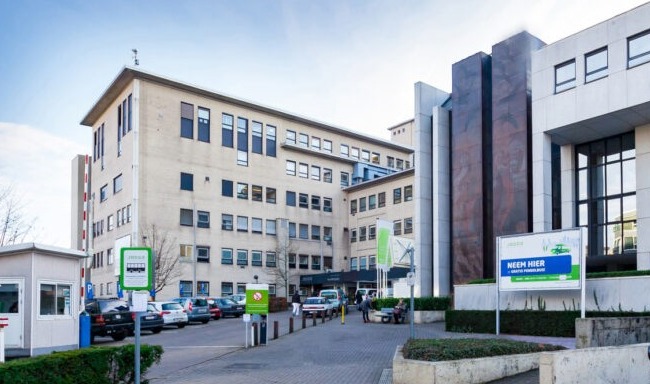Contact the following healthcare facilities directly:
MS Center Melsbroek
AZ Turnhout
Sint-Trudo Sint-Truiden
AZ Glorieux Ronse
AZ Jan Portaels Vilvoorde
Rehabilitation Hospital Inkendaal



Greet Van Hove, Care Manager at H. Hart Hospital Mol
Organizing patient transport in a hospital is a complex operation. Before implementing the CPT app, transportation planning at H. Hart Hospital Mol was largely manual, lacking a structured framework. “Transfers were mostly communicated verbally,” explains Greet Van Hove. “For example, a nurse from the orthopedics department would call to arrange patient transport to radiology. This not only took time but sometimes led to confusion or errors because there was no central system to coordinate everything. Moreover, it occasionally happened that a physical therapist stood by an empty bed because the patient had just left for medical imaging.”
Additionally, logistical staff often had to walk unnecessarily long distances. “There was little visibility into the exact location of patients or their specific needs, such as oxygen supply during transport. This made it difficult to work efficiently and increased the administrative burden,” Greet Van Hove clarifies.

Benjamin Peeters
ICT-director
At H. Hart Hospital Mol
The CPT app digitizes and simplifies the patient transport process within the hospital. The system is seamlessly integrated into the EHR, ensuring smooth information exchange. “Certain structured data, such as patient information and care definitions, flow through automatically. If a patient requires oxygen, for example, this is included in the transport plan.”
Healthcare providers can easily create a transport request, and the app automatically assigns the nearest logistical staff member with an available smartphone. “Another advantage: this integration minimizes errors,” says Benjamin Peeters. “When staff need to transport patients, they can scan the patient’s wristband for identification, significantly enhancing patient safety.”
The CPT app implementation has just been completed, but the results are already promising. “There is now much better control over patient location and transport needs. The number of phone calls between departments has also drastically decreased. This gives healthcare providers more time to focus on patient care.”
Moreover, transport staff now have a clearer overview of their tasks. “They can see on their smartphone where to go and what is expected of them. An added benefit is that the receiving department knows in advance who is coming and what needs to be done,” adds Greet Van Hove.

While the benefits are clear, implementing a new system always requires some adjustment. “There was some initial resistance from staff,” acknowledges Benjamin Peeters. “A new system inevitably brings changes to the daily workflow. But thanks to interactive training and clear quick reference guides, most staff quickly adapted. They find the app user-friendly and now recognize the benefits.”
A possible next step is optimizing walking routes and combining transport tasks to achieve even more efficiency gains. “Some staff wear a pedometer. We were surprised by how much distance logistical staff cover in a day. With the data we are now collecting, we can further streamline these processes in the future,” adds Benjamin Peeters.
Currently, the CPT app is mainly used for patient transport to and from the radiology department. But the hospital sees potential for broader use of the system. Greet Van Hove: “We are considering implementing the app for material transport as well. Think of alternating mattresses or other aids that are centrally rented.”
The initial feedback is positive. The app not only saves time but also provides structure. “Creating a CPT plan is an extra step, but the benefits are well worth it. Everyone now knows exactly where a patient is and the status of a transport request. It was certainly a good initiative by our colleague Ellen Heyns, the hospital’s application manager, to start working with the CPT app,” concludes Greet Van Hove.
The CPT app is an excellent example of how digital innovations can improve healthcare processes. The application enhances efficiency, saves time and energy, and contributes to patient safety. Its user-friendly interface makes it easy for staff to learn and use the app quickly and efficiently. In short: the CPT app is a valuable asset for any hospital. Moreover, there are no additional costs involved. The CPT app is included in the license for healthcare facilities using nexuzhealth’s EHR.

info@nexuzhealth.com
The central platform for every healthcare professional

How can we contribute to the quality of life for our chronically ill patients - those patients who need to come to the hospital regularly for infusion therapy sessions that last for several hours? A working group at AZ Voorkempen took this question to a test group of 11 patients as part of the Safe Fast Infusion (SFI) project.

The use of nexuzhealth consult enables hospitals to collaborate technologically beyond their own walls.

Barely a few weeks after the start-up, the nurses and doctors in intensive care at RZ Heilig Hart Tienen are in full agreement: CWS (Clinical Workstation), the electronic health record, makes all the difference.
We are here for you
The answers to the most frequently asked questions can be found on the website. If you still have questions, please contact the service desk.
MS Center Melsbroek
AZ Turnhout
Sint-Trudo Sint-Truiden
AZ Glorieux Ronse
AZ Jan Portaels Vilvoorde
Rehabilitation Hospital Inkendaal